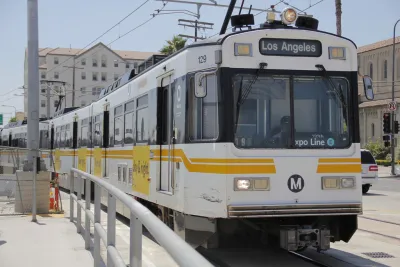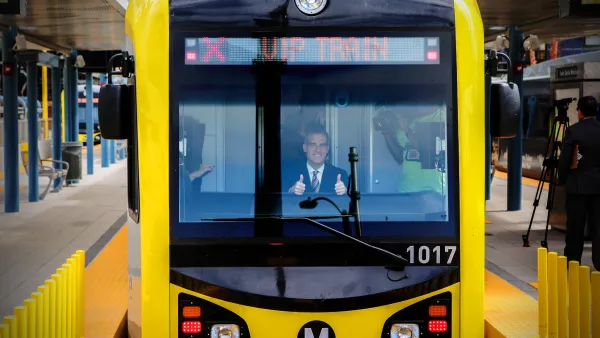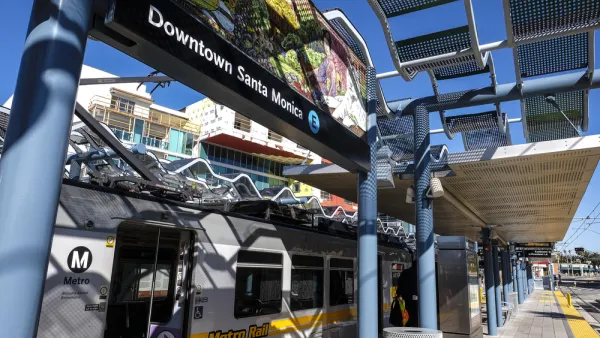The $1.5 billion, 6.6-mile light rail extension from Culver City to Santa Monica is projected to double trips on the line by 2030, giving commuters a viable alternative to driving. Just the same, don't expect the extension to reduce congestion.


Credit: LA Metro Expo Line (note seven new stations: Palms—Santa Monica)
"The light rail extension won’t put a dent in traffic, not in the long run," writes Aarian Marshall for Wired. "But it’s still worth every penny.“
So much for Los Angeles Mayor Eric Garcetti's assurances last February.
The Expo Line connects and crosses through some of our most traffic-ridden corridors,” Garcetti said. “This is a huge step forward in our work to ease congestion.”
Induced demand applies to transit as well as asphalt
Growing the ridership by 35,000 trips to 64,000 in 14 years will be a major feat, but how will the extension impact congestion? Marshall asks transportation expert, Professor Genevieve Giuliano of the University of Southern California (USC) what the effect would be if ten thousand motorists chose to immediately forsake driving and take the Expo Line. Giuliano has been studying the issue.
“Ten thousand vehicles out of literally hundreds of thousands that are moving around—it would be really hard to see,” she says.
In a study published last year, Giuliano and her colleagues used sensor data to take a close look at how the opening of the first phase of the Expo line in 2012 affected congestion in the immediate area. They didn’t see much. “The congestion reduction benefits of [light rail] are likely very limited,” they concluded.
You can thank the rule of induced demand: More space for cars doesn’t mean less traffic, it means more cars. When folks ditch their cars for a smooth and stress-free transit ride, other drivers move to exploit a suddenly less clogged stretch of freeway, either by changing their driving patterns or taking trips they wouldn’t have otherwise. The new Expo Line will move more people more places, sure. But it won’t cure traffic.
Looking at Planetizen posts tagged under the topic, it's easy to see that the concept is generally applied to adding more vehicle capacity, which has the adverse impact of reducing transit ridership, unlike adding transit capacity.
“The best thing you can say is that [the Expo extension] will provide people with an option for traveling in congestion,” says Brian Taylor, director of UCLA’s Institute of Transportation Studies.
Taylor is wary of exorbitant rail projects that are attractive to voters but may "betray 'transit’s critical social service function'": improving the lives of lower income people, particularly when lower-priced, high-frequency bus service may prove more cost effective.
A few streetcar projects that may fall in the category were posted here recently.
A final note on the transit—traffic congestion relationship taught to me by public transit advocate Roy Nakadegawa. While transit may not place much of a dent in traffic congestion, congestion prompts the need to create and improve public transit, as well as adding road capacity. Perhaps the best way to tackle congestion is through economic means.
See more Planetizen coverage of the Expo Line which opened Friday after six years of construction.
Hat tip to Metro Library's L.A. Transportation Headlines
FULL STORY: LA’s New Metro Line Won’t Reduce Traffic—And That’s OK

Analysis: Cybertruck Fatality Rate Far Exceeds That of Ford Pinto
The Tesla Cybertruck was recalled seven times last year.

National Parks Layoffs Will Cause Communities to Lose Billions
Thousands of essential park workers were laid off this week, just before the busy spring break season.

Retro-silient?: America’s First “Eco-burb,” The Woodlands Turns 50
A master-planned community north of Houston offers lessons on green infrastructure and resilient design, but falls short of its founder’s lofty affordability and walkability goals.

Test News Post 1
This is a summary

Analysis: Cybertruck Fatality Rate Far Exceeds That of Ford Pinto
The Tesla Cybertruck was recalled seven times last year.

Test News Headline 46
Test for the image on the front page.
Urban Design for Planners 1: Software Tools
This six-course series explores essential urban design concepts using open source software and equips planners with the tools they need to participate fully in the urban design process.
Planning for Universal Design
Learn the tools for implementing Universal Design in planning regulations.
EMC Planning Group, Inc.
Planetizen
Planetizen
Mpact (formerly Rail~Volution)
Great Falls Development Authority, Inc.
HUDs Office of Policy Development and Research
NYU Wagner Graduate School of Public Service




























